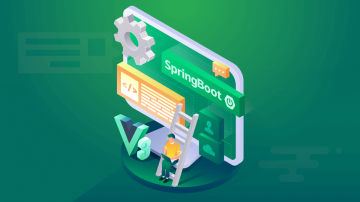本文详细介绍了Spring Boot项目实战,从项目搭建到常用功能详解,再到实战案例和部署运行,帮助开发者快速掌握Spring Boot开发技巧。Spring Boot项目实战涵盖了从入门到高级应用的各个方面,包括自动配置、依赖管理、RESTful API构建、数据库操作和测试调试等内容。此外,文章还提供了详细的实战案例和部署指导,帮助读者深入理解Spring Boot项目开发的最佳实践。
Spring Boot简介Spring Boot是什么
Spring Boot 是一个基于Spring框架的开源框架,旨在简化Spring应用的初始搭建以及开发过程。它通过约定优于配置的方式,帮助开发者快速构建独立的、生产级的基于Spring的应用程序。Spring Boot的设计目标是简化开发者的开发体验,使得开发者能够快速构建健壮的应用程序,而无需过多关注底层配置。
Spring Boot的优势
- 简化配置:Spring Boot 使用约定优于配置的原则来减少配置需求。许多配置的默认值可以直接使用,开发者只需关注应用的业务逻辑。
- 自动配置:Spring Boot 可以根据类路径中的jar包和类自动配置Spring应用程序,从而减少配置文件的编写。
- 开箱即用:Spring Boot 提供了一系列的“起步依赖”(Starters),其中包括常用的库和配置,使开发者能够快速集成这些库。
- 独立运行:Spring Boot 应用程序可以独立运行,无需外部容器。它可以通过
mvn spring-boot:run命令或者java -jar命令启动应用。 - 健康检查:Spring Boot 提供了内置的健康检查端点,可以监控应用的健康状态。
- 嵌入式容器:Spring Boot 可以嵌入Servlet容器,如Tomcat、Jetty或Undertow,并作为独立应用运行。
- Web开发:Spring Boot使得Web开发变得更加简单,支持创建RESTful API,集成Thymeleaf模板引擎等。
Spring Boot的核心概念
- 起步依赖:Spring Boot 提供了多种起步依赖,每个起步依赖都包含了一系列的库和配置。例如,
spring-boot-starter-web提供了构建Web应用所需的所有依赖,而spring-boot-starter-data-jpa则包含了JPA(Java Persistence API)的配置。 - 自动配置:Spring Boot 会根据类路径中的jar包和类自动配置Spring应用程序,减少了对配置文件的需求。
- 命令行接口:通过
spring-boot-maven-plugin或spring-boot-gradle-plugin可以运行和打包Spring Boot 应用程序。 - 健康检查:内置的健康检查端点可以监控应用的健康状态,包括连接到数据库、缓存等服务的健康状态。
- 嵌入式Servlet容器:Spring Boot 应用程序可以直接运行在嵌入式的Servlet容器中,如Tomcat、Jetty或Undertow,无需外部部署。
- Actuator:Spring Boot Actuator 是一个模块,提供了生产环境中运行应用的管理端点。这些端点可以监控应用的状态,执行操作等。
示例说明
以下是一个简单的Spring Boot应用示例:
import org.springframework.boot.SpringApplication;
import org.springframework.boot.autoconfigure.SpringBootApplication;
import org.springframework.web.bind.annotation.GetMapping;
import org.springframework.web.bind.annotation.RestController;
@SpringBootApplication
public class Application {
public static void main(String[] args) {
SpringApplication.run(Application.class, args);
}
}
@RestController
class HelloController {
@GetMapping("/")
String home() {
return "Hello, World!";
}
}在这个例子中,@SpringBootApplication注解是Spring Boot的核心注解,它组合了三个其他注解:@Configuration、@EnableAutoConfiguration和@ComponentScan。HelloController类中使用@RestController注解,创建了一个简单的RESTful接口,返回一个字符串。
使用IDEA创建Spring Boot项目
- 打开IDEA,选择“File” -> “New” -> “Project”。
- 在弹出的界面中,选择Spring Initializr,然后点击“Next”。
- 选择一个语言(Java)和一个Spring Boot版本,然后点击“Next”。
- 填写项目信息,包括项目名、语言、打包方式等。语言选择Java,打包方式选择Jar或War,视项目需要而定。
- 在“Dependencies”中选择需要的起步依赖。例如,选择
spring-boot-starter-web创建一个Web应用。 - 点击“Next”和“Finish”完成创建。
导入依赖和配置文件
在项目创建完成后,需要导入依赖和配置文件。以下是在pom.xml文件中导入依赖的示例代码:
<dependencies>
<dependency>
<groupId>org.springframework.boot</groupId>
<artifactId>spring-boot-starter-web</artifactId>
</dependency>
<dependency>
<groupId>org.springframework.boot</groupId>
<artifactId>spring-boot-starter-data-jpa</artifactId>
</dependency>
<dependency>
<groupId>org.springframework.boot</groupId>
<artifactId>spring-boot-starter-thymeleaf</artifactId>
</dependency>
</dependencies>接着,在src/main/resources目录下创建配置文件application.properties,用于配置数据库连接、服务器端口等:
# application.properties
spring.datasource.url=jdbc:mysql://localhost:3306/mydb
spring.datasource.username=root
spring.datasource.password=root
spring.datasource.driver-class-name=com.mysql.cj.jdbc.Driver
spring.jpa.hibernate.ddl-auto=update
server.port=8080第一个Spring Boot应用
创建一个主程序类,使用Spring Boot的@SpringBootApplication注解来启动应用:
import org.springframework.boot.SpringApplication;
import org.springframework.boot.autoconfigure.SpringBootApplication;
@SpringBootApplication
public class Application {
public static void main(String[] args) {
SpringApplication.run(Application.class, args);
}
}接着,创建一个简单的Controller类,返回“Hello, World!”:
import org.springframework.web.bind.annotation.GetMapping;
import org.springframework.web.bind.annotation.RestController;
@RestController
public class HelloWorldController {
@GetMapping("/")
public String hello() {
return "Hello, World!";
}
}最后,运行应用。在IDEA中,右键点击Application类,选择“Run 'Application.main()'”,或者在命令行中运行:
mvn spring-boot:run应用启动后,可以在浏览器中访问http://localhost:8080/,页面会返回“Hello, World!”。
自动配置原理
Spring Boot 的自动配置机制利用@EnableAutoConfiguration注解来自动配置应用程序。Spring Boot 会检查类路径中的jar包和类,然后根据这些信息自动配置应用程序。例如,如果发现Web应用需要使用Tomcat作为Servlet容器,Spring Boot会自动配置Tomcat。Spring Boot通过SpringBootConfiguration注解来引导自动配置过程。
以下是一个简单的自动配置示例:
import org.springframework.boot.SpringApplication;
import org.springframework.boot.autoconfigure.SpringBootApplication;
import org.springframework.context.annotation.Configuration;
import org.springframework.context.annotation.EnableAutoConfiguration;
@SpringBootApplication
public class AutoConfigurationExample {
public static void main(String[] args) {
SpringApplication.run(AutoConfigurationExample.class, args);
}
}使用Spring Boot启动器
Spring Boot 启动器是一个项目依赖集合。每个启动器都包含了一系列的库和配置,使得开发者能够快速集成这些库。例如,spring-boot-starter-web启动器包含了创建一个简单的Web应用所需的所有库。
<dependency>
<groupId>org.springframework.boot</groupId>
<artifactId>spring-boot-starter-web</artifactId>
</dependency>常用注解介绍
-
@SpringBootApplication:
- 该注解组合了
@Configuration、@EnableAutoConfiguration和@ComponentScan注解。它表示这是一个Spring Boot应用的入口。 - 代码示例:
@SpringBootApplication public class Application { public static void main(String[] args) { SpringApplication.run(Application.class, args); } }
- 该注解组合了
-
@RestController:
- 用于定义一个RESTful控制器,简化了控制器的定义。等同于
@Controller和@ResponseBody的组合。 - 代码示例:
@RestController public class HelloWorldController { @GetMapping("/") public String hello() { return "Hello, World!"; } }
- 用于定义一个RESTful控制器,简化了控制器的定义。等同于
-
@Service:
- 定义一个服务类,用于包含业务逻辑。
- 代码示例:
@Service public class UserService { public User getUserById(Long id) { // 业务逻辑 return new User(); } }
-
@Repository:
- 定义一个数据访问层类,通常用于访问数据库。Spring Boot 会自动配置数据访问层的连接。
- 代码示例:
@Repository public class UserRepository { public User getUserById(Long id) { // 数据访问逻辑 return new User(); } }
-
@ComponentScan:
- 指定组件扫描的基包路径,Spring Boot 会扫描该路径下的所有组件,如控制器、服务、仓库等。
- 代码示例:
@ComponentScan(basePackages = "com.example.demo") public class Application { public static void main(String[] args) { SpringApplication.run(Application.class, args); } }
-
@EnableAutoConfiguration:
- 启用自动配置机制,根据类路径中的jar包和类自动配置Spring应用程序。
- 代码示例:
@EnableAutoConfiguration public class Application { public static void main(String[] args) { SpringApplication.run(Application.class, args); } }
-
@Configuration:
- 定义一个配置类,用于配置Spring的应用程序上下文。
- 代码示例:
@Configuration public class AppConfig { @Bean public MyService myService() { return new MyService(); } }
- @Bean:
- 用于定义一个Spring Bean,Spring容器会管理该Bean的创建和销毁。
- 代码示例:
@Configuration public class AppConfig { @Bean public MyService myService() { return new MyService(); } }
创建RESTful API
创建一个简单的RESTful API,可以使用Spring Boot的@RestController注解来定义控制器。以下是创建RESTful API的一个用户控制器示例:
import org.springframework.http.ResponseEntity;
import org.springframework.web.bind.annotation.*;
@RestController
@RequestMapping("/api/users")
public class UserController {
@GetMapping("/{id}")
public ResponseEntity<User> getUserById(@PathVariable Long id) {
User user = userService.getUserById(id);
return ResponseEntity.ok(user);
}
@PostMapping
public ResponseEntity<User> createUser(@RequestBody User user) {
User createdUser = userService.createUser(user);
return ResponseEntity.created(URI.create("/api/users/" + createdUser.getId())).body(createdUser);
}
}使用JPA进行数据库操作
Spring Boot支持JPA(Java Persistence API)来简化数据库操作。通过@Repository注解定义一个仓库类,并使用JPA的@Entity注解定义数据模型。
import javax.persistence.*;
import java.util.List;
@Entity
public class User {
@Id
@GeneratedValue(strategy = GenerationType.IDENTITY)
private Long id;
private String name;
private String email;
// getters and setters omitted for brevity
}
@Repository
public class UserRepository {
@PersistenceContext
private EntityManager entityManager;
public User getUserById(Long id) {
return entityManager.find(User.class, id);
}
public User createUser(User user) {
entityManager.persist(user);
return user;
}
public List<User> findAllUsers() {
return entityManager.createQuery("SELECT u FROM User u", User.class).getResultList();
}
}集成Thymeleaf模板引擎
Thymeleaf是一个现代的服务器端Java模板引擎,可以用来渲染HTML、XML和纯文本模板。Spring Boot支持Thymeleaf作为默认的视图模板引擎。
import org.springframework.stereotype.Controller;
import org.springframework.ui.Model;
import org.springframework.web.bind.annotation.GetMapping;
@Controller
public class HomeController {
@GetMapping("/")
public String home(Model model) {
List<User> users = userService.findAllUsers();
model.addAttribute("users", users);
return "home";
}
}在src/main/resources/templates目录下创建home.html文件,使用Thymeleaf模板渲染用户列表:
<!DOCTYPE html>
<html xmlns:th="http://www.thymeleaf.org">
<head>
<title>Home Page</title>
</head>
<body>
<h1>Welcome to the Home Page!</h1>
<table>
<tr>
<th>ID</th>
<th>Name</th>
<th>Email</th>
</tr>
<tr th:each="user, status : ${users}">
<td th:text="${user.id}"></td>
<td th:text="${user.name}"></td>
<td th:text="${user.email}"></td>
</tr>
</table>
</body>
</html>单元测试与集成测试
单元测试主要用于测试单个类的方法。Spring Boot支持使用JUnit和Mockito等库进行单元测试。以下是一个单元测试示例:
import org.junit.jupiter.api.Test;
import org.mockito.InjectMocks;
import org.mockito.Mock;
import static org.junit.jupiter.api.Assertions.assertEquals;
import static org.mockito.Mockito.when;
public class UserServiceTest {
@Mock
private UserRepository userRepository;
@InjectMocks
private UserService userService;
@Test
public void testFindUserById() {
User user = new User(1L, "John Doe", "john.doe@example.com");
when(userRepository.getUserById(1L)).thenReturn(user);
User result = userService.getUserById(1L);
assertEquals(user, result);
}
}集成测试主要用于测试组件间的协作。以下是一个集成测试示例:
import org.junit.jupiter.api.Test;
import org.springframework.beans.factory.annotation.Autowired;
import org.springframework.boot.test.context.SpringBootTest;
import static org.junit.jupiter.api.Assertions.assertEquals;
@SpringBootTest
public class UserRepositoryIntegrationTest {
@Autowired
private UserRepository userRepository;
@Test
public void testFindUserById() {
User user = userRepository.getUserById(1L);
assertEquals("John Doe", user.getName());
}
}异常处理
Spring Boot支持自定义异常处理类来处理常见的错误。以下是一个简单的异常处理示例:
import org.springframework.http.HttpStatus;
import org.springframework.http.ResponseEntity;
import org.springframework.web.bind.annotation.ControllerAdvice;
import org.springframework.web.bind.annotation.ExceptionHandler;
import org.springframework.web.bind.annotation.ResponseBody;
@ControllerAdvice
public class GlobalExceptionHandler {
@ExceptionHandler(ResourceNotFoundException.class)
@ResponseBody
public ResponseEntity<ErrorResponse> handleResourceNotFoundException(ResourceNotFoundException ex) {
ErrorResponse errorResponse = new ErrorResponse(ex.getMessage(), HttpStatus.NOT_FOUND.value());
return new ResponseEntity<>(errorResponse, HttpStatus.NOT_FOUND);
}
public class ErrorResponse {
private String message;
private int status;
public ErrorResponse(String message, int status) {
this.message = message;
this.status = status;
}
// getters and setters omitted for brevity
}
}日志管理
Spring Boot 使用Log4j或Logback等日志框架。可以通过添加日志配置文件来管理日志输出。例如,创建logback-spring.xml配置文件:
<configuration>
<appender name="STDOUT" class="ch.qos.logback.core.ConsoleAppender">
<encoder>
<pattern>%d{yyyy-MM-dd HH:mm:ss} %-5level %logger{36} - %msg%n</pattern>
</encoder>
</appender>
<root level="info">
<appender-ref ref="STDOUT" />
</root>
</configuration>打包Spring Boot应用
可以通过Maven或Gradle打包Spring Boot应用。以下是一个Maven的pom.xml配置:
<build>
<plugins>
<plugin>
<groupId>org.springframework.boot</groupId>
<artifactId>spring-boot-maven-plugin</artifactId>
</plugin>
</plugins>
</build>使用Maven命令打包:
mvn clean package生成的jar文件位于target目录下。
在Tomcat和Docker中部署
使用Tomcat部署
Spring Boot 默认可以嵌入Tomcat容器运行,但在生产环境中通常会将应用部署在外部的Tomcat服务器上。
- 部署:将生成的jar文件复制到Tomcat的
webapps目录下。 - 启动Tomcat:启动Tomcat服务器,应用会自动部署并运行。
使用Docker部署
使用Docker可以更方便地管理和部署应用。以下是一个简单的Dockerfile示例:
FROM openjdk:11-jre-slim
COPY target/*.jar app.jar
ENTRYPOINT ["java","-jar","/app.jar"]构建Docker镜像:
docker build -t my-spring-boot-app .运行Docker容器:
docker run -p 8080:8080 my-spring-boot-app监控与性能优化
应用监控
Spring Boot Actuator 提供了一系列的内置端点来监控应用的状态,包括health、info、metrics等。
启用Actuator端点:
management:
endpoints:
web:
exposure:
include: "*"性能优化
- 配置线程池:使用
ThreadPoolTaskExecutor配置线程池。 - 缓存策略:使用
@Cacheable注解缓存频繁访问的数据。 - 异步处理:使用
@Async注解异步处理耗时任务。
import org.springframework.cache.annotation.Cacheable;
import org.springframework.scheduling.annotation.Async;
import org.springframework.scheduling.annotation.EnableAsync;
import org.springframework.web.bind.annotation.GetMapping;
import org.springframework.web.bind.annotation.RestController;
@RestController
@EnableAsync
public class AsyncController {
@GetMapping("/async-operation")
@Async
public String asyncOperation() {
// 异步执行的逻辑
return "Operation completed asynchronously";
}
@GetMapping("/get-data")
@Cacheable("data")
public String getData() {
// 获取数据的逻辑
return "Cached Data";
}
}以上是Spring Boot项目的入门与初级教程,涵盖项目搭建、常用功能、实战案例、测试调试、部署运行和监控优化。希望这些内容能帮助你快速掌握Spring Boot开发技巧。

 随时随地看视频
随时随地看视频




